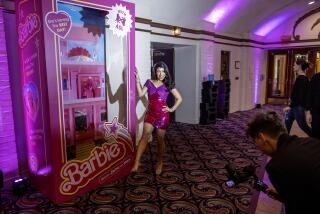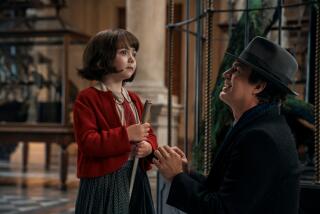Giving the Blind a Better Picture of Film Action
- Share via
Ten-year-old Giselle Fernandez had never been to the movies before Sunday.
The Pasadena resident can make out vague shapes of light and dark but can only watch videos at home with help from her mother, who tells her what is happening on the screen.
But thanks to a special CD that lays narration over film soundtracks, Giselle and other sight-impaired moviegoers Sunday got to better experience “Harry Potter and the Prisoner of Azkaban” at the Laemmle Theatre in Santa Monica. Giselle laughed out loud as a London-accented voice described a spider wearing roller skates, and she drew in her breath when Harry was in trouble.
“This was excellent,” said Sandra Fernandez, Giselle’s mother. “She loves doing the same thing as other regular children. Now she can talk to them about the movie too.”
Giselle said that although she enjoys her mother’s descriptions of videos at home, this experience was better because she could more easily picture in her mind what was happening on screen.
“It was great,” she said, unable to stop smiling.
Organized by the Center for the Partially Sighted, the Sight & Sound Foundation and Describedmedia.com, the special viewing drew about 100 people -- some carrying canes, others holding the elbows of loved ones and one led by a guide dog.
Although a handful of theaters in Los Angeles provide headsets that broadcast descriptions for the visually impaired, organizers of Sunday’s event believed it was the first time in the region that the entire audience could listen to “audio described narration” without headsets.
The technology was pioneered in the early 1980s by the U.S. Department of Education, the American Foundation for the Blind and WGBH, a public television station in Boston, said Dana Walker, co-founder of the Sight & Sound Foundation.
“I think because of the additional cost involved, [television networks and film studios] have been resistant to embracing audio described narration,” he said. “We hope to promote an increased awareness about its existence.”
Walker said 13 million visually impaired people in this country could benefit from the technology. He hopes that more Hollywood studios will add the narration to their films just as they now do with foreign languages. His foundation also hopes people will donate money so the group can buy more narrated videos for schools and libraries.
The movie theater opened early for the special screening and gave the organizers a discounted rate. Sam King, one of the managers at Laemmle, helped to figure out how to hook up the computer equipment lent by Dolby for the theater’s speakers.
“The problem with the headsets is, you can hear [the narrator] talking, but it sort of blocks out the rest of the movie,” King said. “But I thought this sounded amazing.”
Samuel Genensky said he was glad he could leave his binoculars at home. Normally, the only way the 77-year-old can enjoy movies is to sit in the middle of the theater and sweep his binoculars back and forth across the screen.
“This gave me a sense of what was going on,” he said, calling the descriptions “first class.”
Some families with visually impaired members are reluctant to go to movies because they don’t want to bother other audience members with their oral explanations, said Ladonna Ringering, executive director of the Center for the Partially Sighted.
“It’s even better for our older clients who can get so isolated,” she said of the narration technology.
Sonya Chapnick, a 39-year-old Santa Monica resident who is legally blind, said she goes to movies regardless of whether special help is available. A couple of weeks ago, she and her husband went to “The Incredibles.”
“Sometimes with quick action, he can’t fill in the blanks fast enough,” Chapnick said. “I kept nudging him and he said, ‘Which part do you want me to explain?’ ”
Chapnick, who had been to “Harry Potter and the Prisoner of Azkaban” before, said this experience was much better.
“There were some details I missed,” said Chapnick, who has difficulty distinguishing movement on dark backgrounds. “When they were on the train and [the narrator] said Harry was looking at his reflection in the window -- I couldn’t see that.”
“I had a lot less to work to do,” said Chapnick’s husband, Adam, as he smiled at his wife. “Not that I mind, but it’s nice.”
More to Read
The biggest entertainment stories
Get our big stories about Hollywood, film, television, music, arts, culture and more right in your inbox as soon as they publish.
You may occasionally receive promotional content from the Los Angeles Times.










